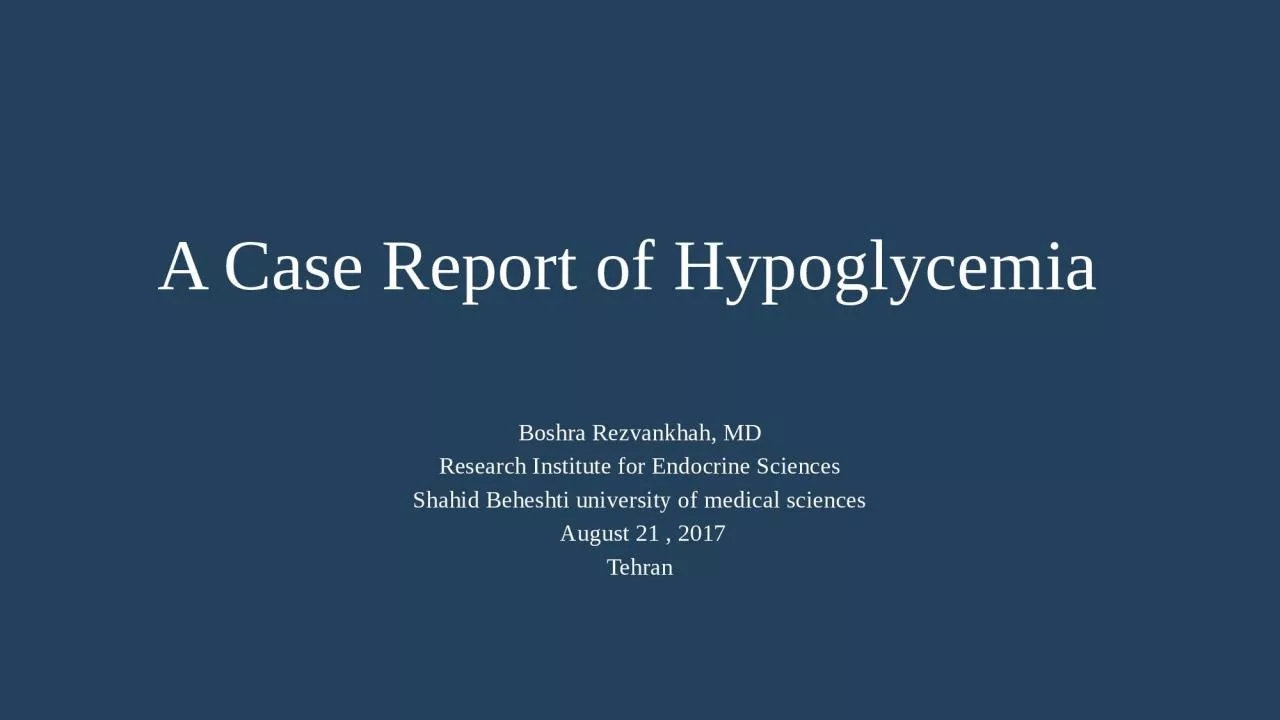

Boshra Rezvankhah MD Research Institute for Endocrine Sciences Shahid Beheshti university of medical sciences August 21 2017 Tehran DDx NonIslet Cell Tumors Endocrine Reviews May 13 2013 ID: 930463
Download Presentation The PPT/PDF document "A Case Report of Hy poglycemia" is the property of its rightful owner. Permission is granted to download and print the materials on this web site for personal, non-commercial use only, and to display it on your personal computer provided you do not modify the materials and that you retain all copyright notices contained in the materials. By downloading content from our website, you accept the terms of this agreement.
Slide1
A Case Report of Hypoglycemia
Boshra
Rezvankhah
,
MD
Research Institute for Endocrine Sciences
Shahid
Beheshti
university of medical sciences
August
21
,
2017
Tehran
Slide2DDx
Slide3Slide4Non-Islet Cell Tumors
Endocrine Reviews. May 13, 2013
Slide5Endocrine Reviews. May 13, 2013
Slide6Slide7We analyzed the medical records of 78 patients with NICTH (
M/F 44/34
, age 62 ± 1.8, range; 9–86 years.) whose serum contained a large amount of big IGF-II.
Hepatocellular
carcinoma and
gastric carcinoma
were the most common causes of NICTH.
The
diameters of the tumors were more than 10 cm in 70% of the patients.
Hypoglycemic
attack was the onset of
disease in
31 of 65 cases (48
%).
Twenty-five
of
47 (53
%) patients had decreased serum potassium levels.
Slide8Slide9Slide10J
Clin Endocrinol Metab
, 2014
Slide11Diagnosis
Depending on the
specific IGF-II
assay used, the IGF-II levels may or may not
be elevated
in
NICTH.
Even
if IGF-II levels are
normal (approximate
normal range, 275–750 ng/mL,
depending on
the laboratory used), the IGF-I levels are
suppressed under
100
ng/mL
The IGF-II:IGF-I
ratio is elevated
above the normal molar ratio
of 3:1 and
often approaching or exceeding
10:1.
There
is no commercially
available assay
for big
IGF-II
Slide12In cases in which it is unclear whether hypoglycemia is due
to IGF-II or another etiology (
eg
, liver failure due
to metastatic
disease with depleted glycogen stores), a
glucagon-stimulation
test can be employed.
Next step in diagnosis
is cross-sectional imaging of the chest,
abdomen,and
pelvis to identify a tumor, given that the
vast majority
of reported cases of NICTH involve a tumor in
one of
these
sites(1/3 interthorasic,2/3 intra abdominal & retroperitoneal)
Slide13Isolated ACTH deficiency
E
pidemiological
study of
IAD
in a Japanese cohort, population size: 1.15-1.17 million-inhabitants, has shown that its prevalence and incidence were
19.1 cases/million
and 0.9 cases/year/million, respectively, whereas 85.9 case/million and 5.3 cases/year/million, respectively, for acromegaly in the same
cohort.
The prevalence of secondary AI,
most commonly
due to glucocorticoid administration, is
much higher
than that of primary AI, with an estimate of
150–280 cases
per
million
.
Isolated ACTH Deficiency: Epidemiology, Clinical Features and Secretory Dynamics of Plasma ACTH By a Novel Ultrasensitive EIA
2014
Slide14Autoimmune
Most
cases are caused by an autoimmune
process;frequent
association with other autoimmune endocrine disorders
The
presence of
antipituitary
antibodies in the serum of 10 of 21
patients.
2017 Up To Date
Slide15Genetic
causes
:
Mutations
in the POMC gene
A
syndrome of early onset obesity and secondary adrenal insufficiency has been described in seven patients with homozygous or compound heterozygous loss-of-function mutations in the proopiomelanocortin (POMC)
gene.
Their heterozygote relatives were unaffected, indicating a recessive mode of inheritance.
Cleavage
enzyme defect
Another
cause of isolated ACTH deficiency is a congenital defect leading to impaired function of pro-hormone convertase 1 (PC1), which cleaves ACTH from
POMC.
TPIT
gene mutations
TPIT
is a transcription factor necessary for differentiation of the
corticotroph
cell and POMC production; TPIT gene mutations may be the most common genetic cause of neonatal isolated ACTH deficiency (IAD).
All
parents of the neonates with TPIT mutations were unaffected carriers, confirming a recessive mode of inheritance. Although IAD due to TPIT mutations is a rare
2017 Up To Date
Slide16Reactive Hypoglycemia
Reactive
hypoglycemia refers to hypoglycemia that
occurs after
meals. Any condition that causes fasting
hypoglycemia,for
example,
insulinoma,hypopituitarism,alcoholism,sulfonylurea
ingestion, hypothyroidism
,
growth hormone
deficiency,and
cortisol
deficiency,can
also cause postprandial
hypoglycemia.
Nevertheless
, some conditions are associated with
hypoglycemia only
after meal ingestion. These conditions
fall into
four categories: alimentary, prediabetes,
idiopathic
, and
functional hypoglycemia
Degroot-2016
Slide17Idiopathic Reactive Hypoglycemia
Idiopathic reactive
hypoglycemia is
an extremely
rare
condition.
For
this diagnosis to be made,
patients must
demonstrate arterial/capillary
hypoglycemia (<
50 mg/
dL
; 2.8
mmol
/L) after everyday meals (
not OGTTs
), which is associated with symptoms of
hypoglycemia that
are relieved by carbohydrate ingestion
Without
any other known cause (e.g., prior
gastrointestinal surgery
, peptic ulcer disease, glucose
intolerance, endocrine
deficiency
)
Degroot-2016
Slide18Slide19Slide20Slide21Pathophisiology:
Impaired glucagon
counterregulatory
responses
,
Excessive GLP-1 secretion,
Abnormal
neuroendocrine
regulation of
insulin
release,
Increased
insulin
sensitivity
,
Increased
β-adrenergic
sensitivity,
Renal glycosuria
Slide22Dietary TreatmentLow carbohydrate diet & frequent small split meals.
Avoidance of rapidly absorbed sugar & soft drinks rich in glucose.
Addition of soluble dietary fibers.
If the patient experiences aggravation of symptoms in presence of low carbohydrate
diet,one
should suspect 1-6 diphosphatase enzyme deficiency and the diet should be increased in carbohydrate
Slide23Pharmacological Approacha-glucosidase inhibitor (treatment of choice)
Metformin,Atropin
,
,
Probanthin,
Phenytoin,Propranolole,Ca
Antagonist,Diazoxide
Somatostatin analogues (in severe cases due to glucose-6-phosphatase deficiency)
Slide24What about Factitious Hypoglycemia?
Slide25J
Clin
Res
Pediatr
Endocrinol
2014;6(4):258-261
Slide26Non-Insulin Mediated Idiopathic Postprandial Hypoglycemia??
What's our plan for the patient?
Slide27Thank You